THURSDAY
OCTOBER 31 - 2019
Spotted
Redshank returns!
After much
waiting, looking and worrying, this morning's trip to
Nore Barn was rewarded with the return of the famous
Spotted Redshank for the 16th winter running. I got to
Nore Barn at about 09.45 in good time to watch the
tide rising. The weather was perfect for birdwatching,
calm, cloudy, a bit misty with a slight chill in the
air. Here is a view looking down the channel from the
stream towards Thorney Island in the distance.
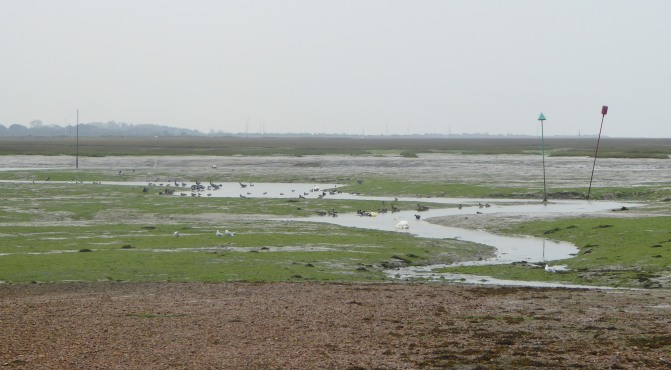
I spent the first 30
minutes or so going through the Brent Geese, Wigeon
and Black-tailed Godwits in the channel

72 Wigeon clustered
along the channels near the shore along with a few
Teal.
62 Brent Geese,
including 5 juveniles in three families of 3, 1 and 1
youngsters respectively. It is looking promising for a
decent Brent breeding season for a change. Here is a
shot I got through the scope showing two families, one
with three juveniles and one with one. Juveniles have
white bars on their folded wings.

I noticed one Brent
with white markings on its back and underside, which I
think must be a plumage aberration of a regular
Dark-bellied Brent Goose. This marking will help us
keep track of this bird's movements.
50+ Black-tailed
Godwits including two regular colour-ringed birds:
R+GL and G+WR.
At about 10.15 I was
pleased to meet up with Emily from Solent Aware who
had set up her notice and scope at the end of
Warblington Road, informing passers-by about the birds
to be seen in the harbour - and a very good job she
was doing too!
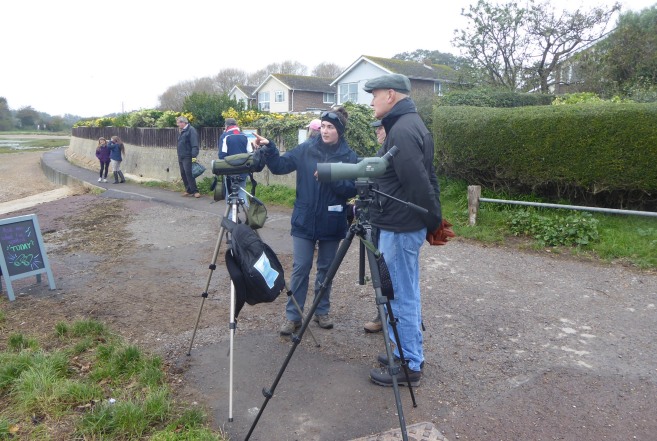
Well, Emily and I were
chatting when I noticed a pale bird suddenly turn up
on the far bank of the main channel from the stream.
At first, I thought it was probably the regular
colour-ringed Greenshank, but when I looked through my
scope ... Wow! That was it. The Spotted Redshank had
arrived! I felt like giving Emily a big hug as she was
my lucky mascot, but felt that would not be in order!
Funny how these things happen; my first sighting of
the Spotted Redshank last year was with my grandson
Joe last year and this year I was with Emily.
The Spotted Redshank spent some time half snoozing on
the edge of the channel where it had one of the
colour-ringed Black-tailed Godwits (R+LG) for company
for a little while.
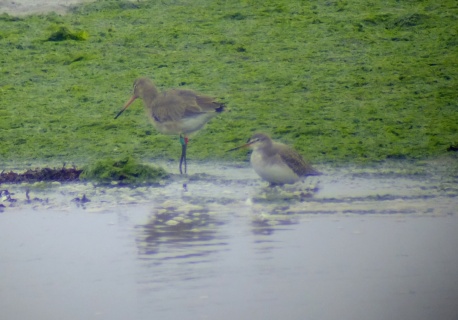
Eventually, the
Spotted Redshank moved further upstream, looking
sprightly and none the worse for its journey from
Scandinavia
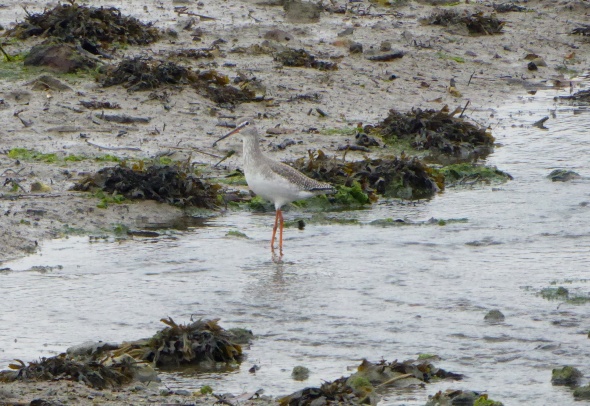
Did you think I would
not make it?
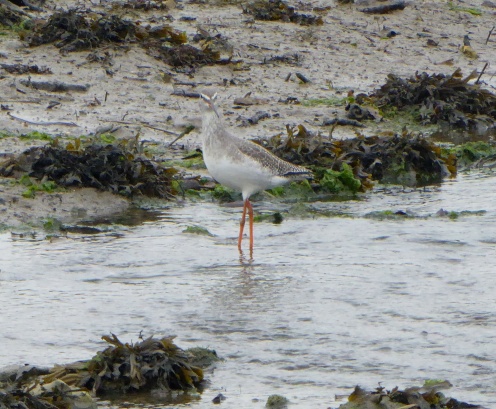
When in the stream it
met up with the colour-ringed Greenshank (G+GL) which
has been its long standing feeding companion over many
years. The Greenshank has had to put up with the
company of a Common Redshank for the past month, but
there was no hiding its delight to see the Spotted
Redshank appear. Sorry to get a bit anthropomorphic
but that is how I saw it!
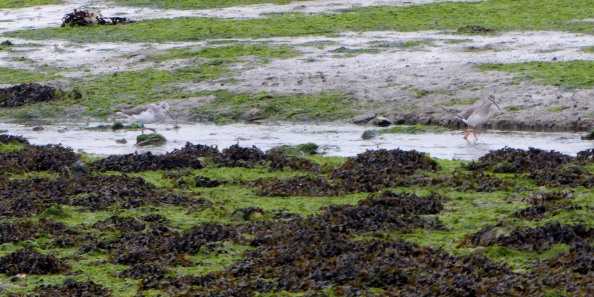
Here is a video clip
of the moment the two birds met in the stream.
Apologies for the heavy breathing!
Go to . . . https://youtu.be/jBIZBjldeYE
Later on I found the
Spotted Redshank further upstream close to the small
footbridge where it usually prefers to feed when
undisturbed. This is where I got more video footage .
. . https://youtu.be/tN7s4IciHsQ
What an incredible
bird. It must be at least 16 years old which far
exceeds the longevity record for this species, but, of
course, the authorities would not accept this record
as it is not ringed or marked in any way. But I know
it is the same bird!
For full details of this bird's history in Emsworth go
to . . . Spotted
Redshank at Nore Barn
TUESDAY
OCTOBER 29 - 2019
Nore
Barn
I got to Nore
Barn at 9am with tide rising and about 3 hours to high
water. I stayed for an hour as the tide gradually
filled the stream. Greenshank (G+GL) and Common
Redshank were feeding in the stream along with a brief
visit from a Little Egret.
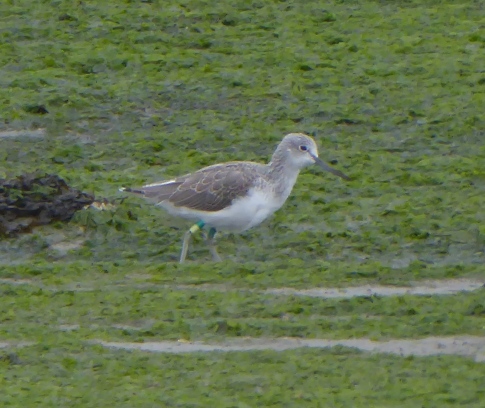
But alas, there is
still no Spotted Redshank. Today (Oct 29th) was the
date of my first sighting of this famous bird last
year. I remember the occasion well as I was
accompanied by my grandson, Joe. Maybe I should have
got him to come along today? Here is a picture of Joe
trying to take a photo of the Spotted Redshank last
year.
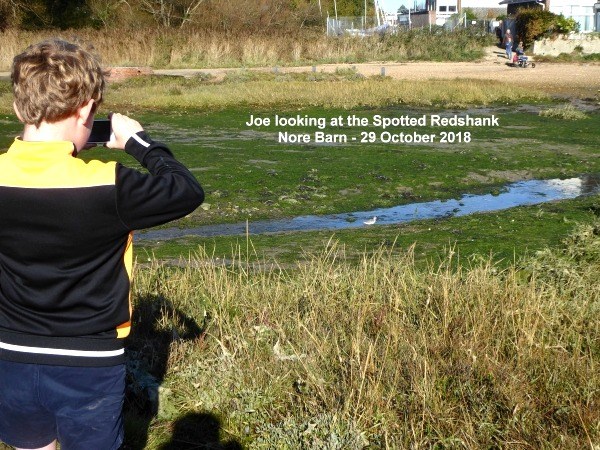
As it so happened we
were looking after Joe this afternoon and I asked him
if he would like to come with me to have another look
at the Nore Barn stream on the falling tide at 3pm. He
jumped at the chance, but we had no luck. The
Greenshank and the Redshank were still in the stream,
but no Spotted Redshank. We did not stay long as there
was clearly not much hope. Maybe we can try again
tomorrow.
High tide tomorrow is 12:30pm but I shall not be able
to do the rising tide as it is my volunteer day at the
Pallant Gallery. However, I hope to check the stream
on the falling tide at around 3.30pm, maybe with Joe.
Things are starting to look grim, but I shall be
monitoring the stream for another week or so just in
case. I am encouraged by the fact that the first date
has got progressively later over the past 4 years:
27-Sep-2015, 11-Oct-2016, 22-Oct-2017 and
29-Oct-2018.
For details of all the previous first and last dates
for the Spotted Redshank go to . . . Spotted
Redshanks at Nore Barn
I counted 73
Black-tailed Godwits on the mudflats including the
two regular colour-ringed birds: R+LG and W+WN.
My only other
observation of interest from this morning's visit was
my first Brent Goose family of the season with
two adults and one juvenile. Peter Milinets-Raby has
already had three juvenile Brent Geese at Langstone so
hopefully, the Brents have had a good breeding season.
Photo taken through my scope.

Brook
Meadow
Maurice Lillie
reports that after five and a half months the path
edges on Brook Meadow have been trimmed.
Maurice also reports that on Sunday, Nigel cut all
around the five cherry trees and Frank's Seat, in
readiness for Emsworth Junior School's charity event
on 18th December. While he was doing this Maurice made
a start on the steps behind the seat.

This morning Terry and
Dan helped to finish off the steps and lay gravel on
the treads.
MONDAY
OCTOBER 28 - 2019
Nore
Barn
I got to Nore
Barn at 8.15am with high water due in about 3 hours.
It was a beautiful autumn morning with good light and
no wind and a chill in the air. As you can see from
the photo, the tide was coming in and the stream
filling up. Ideal conditions for the Spotted Redshank
to turn up!

I stayed for about an
hour during most of which the regulars, Greenshank
(G+GL) and Common Redshank, were feeding in the
stream. But there was no sign yet of the famous
Spotted Redshank. We are getting very close to
seriously worrying time! Is it coming back this year?

It was good to chat
with my friend Susan Kelly who had just been for a
walk along the shore.
I spent time going
through the 58 Black-tailed Godwits feeding on
the mudflats. Here are a few of them

The flock included 2
colour-ringed birds with exactly the same colour rings
on their legs, but arranged in different combinations,
so easily mixed up!
R+GL - This has
been a regular winter visitor to Emsworth Harbour over
the past 9 years. Black-tailed Godwit R+GL was first
recorded in Emsworth 10-Sep-10. Today's was my first
sighting of the present season and my 40th in total.
R+LG - This
bird has also been a regular winter visitor to
Emsworth Harbour since its first sighting on
23-Oct-13. This was my 4th sighting this season and my
21st in total since 2013.
Also in the flock was
W+WN - This bird is a firm favourite in
Emsworth. This was my 3rd sighting of the present
season and my 73rd in total since my first on
18-Oct-10.
Black-tailed
Godwits R+LG and W+WN. I did not get R+GL
I have heard from Pete
Potts about the colour-ringed bird I was not able to
identify at Nore Barn yesterday. From my photo Pete
confirmed it was Y+BB (and not Y+LG as I
thought at first). Pete sent me the complete life
history of the bird. It was originally ringed on
05-Sep-10 at Farlington Marshes by Pete Potts and his
team. It has been seen regularly each winter since
then, mainly at Farlington, Northney and Hayling. This
was the first Emsworth Harbour sighting of Godwit
Y+BB.

SUNDAY
OCTOBER 27 - 2019
Nore
Barn
I popped over
to Nore Barn to check for the Spotted Redshank at
about 2.30pm with tide falling. In fact, there were no
birds in the stream at all. I did find a flock of
about 50 Black-tailed Godwits on the emerging
mudflats.

There was one
colour-ringed bird that I did not recognise. It looked
like Y+LG which I have no record of. I have asked Pete
Potts for help.

Brook
Meadow
Later this
afternoon, I walked through Brook Meadow and round
Slipper Millpond.
I was interested to see that the area around the
Cherry trees behind Frank's seat on the west side of
the north meadow had been cleared. I assume this is in
anticipation of the natural Christmas decorations that
Dan Mortimer is planning for the trees.

As shown in the
following photo the 'ailing' Black Poplar on the right
has now shed all its foliage, whereas the tree on the
left still has a good bushy crown. I am advised the
leaf loss on the right side tree may be normal autumn
decline. However, I shall keep an eye on it.

I usually check any
remaining Hogweed flower heads alongside the main
river path for any insect life. Today I found this
magnificent Shield bug with bright red legs feeding on
one of the flower heads. I have seen this insect
before on the meadow. Following Michael Chinery's
'Collins Guide to Insects' I have always known it as a
Forest Bug (Pentatoma rufipes), but
another of my field guides (by Paul Brock) calls it
Red-legged Shieldbug which I think is far more
appropriate! So I shall use that name in future.

Malcolm Phillips was
also on the meadow this morning for his final visit
before returning to his home in Cuba on Wednesday.
Malcolm was on good form as usual, sending me photos
of some interesting birds that he had spotted. Bon
voyage, but we miss you Malcolm on Brook Meadow!
Great Spotted
Woodpecker (female)

Chiffchaff . . . .
Goldcrest
Chidham
Neill Foster
reported on Saturday's walk by the Friends of Wildlife
group
A group of eight met at Thornham Lane on an overcast
and windy morning. After an assessment of the
conditions, particularly the exceptionally high tide
and strong south-westerly wind, it was agreed it would
be better to relocate to the Chidham peninsular.
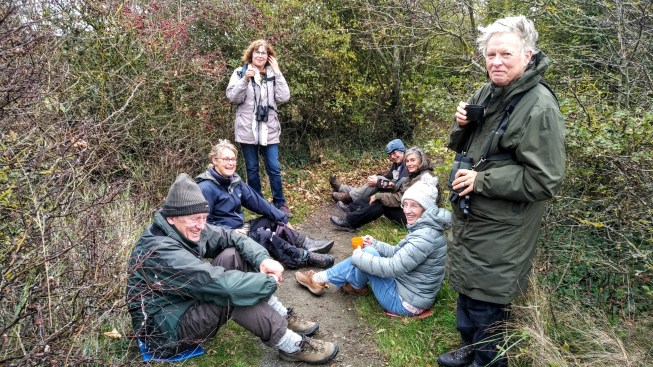
From the car park
there, along the field boundary to the shoreline, we
straightaway could see more of interest. Flying above
the field were a flock of thirty meadow pipits, a
couple of skylarks and a cormorant. In flower along
the footpath were black nightshade, wild carrot, hedge
mustard, shepherd's purse, groundsel, scentless
mayweed, an unconfirmed speedwell species, smooth
sowthistle and red deadnettle.
At the shore, pintail and brent geese were flying; a
little grebe and about thirty brents were on the
water.
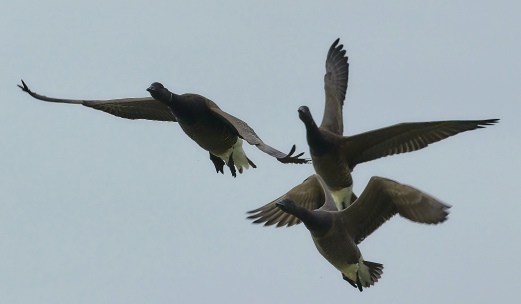
A wren was heard in
the bushes but not seen. Along the coastal path the
red and orange of glasswort and other species made a
colourful display along the landside channel and there
was bristly oxtongue, gorse, white deadnettle.
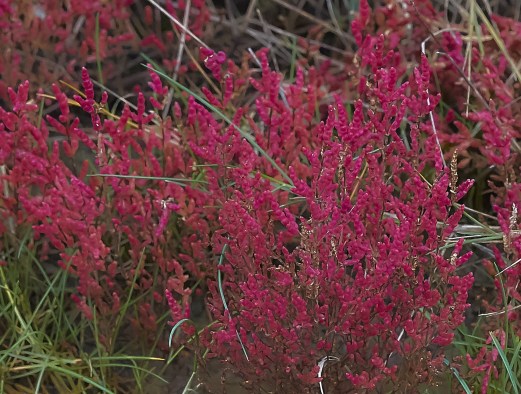
Some had a brief view
of a small mammal swimming ashore from the sea and
Derek was quick enough to capture a picture before it
vanished into the marginal plants. Opinion was divided
between either a small brown rat or a water vole.
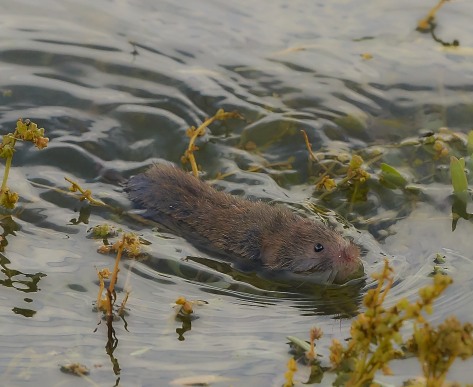
Further along we found
some teals, mallards, a blue tit, moorhens,
greenshanks (group of six), black-tailed godwit,
redshanks, little egrets, stonechats (a few
individuals, including one carrying food), jackdaws (a
large flock over), a couple of chaffinches, a green
woodpecker, oystercatchers (roosting in a long row),
curlews, and rock pipits. Amongst another group of
brent geese on the tidal lake was one unusual
individual with a white head and black face: partial
leucism or possibly a hybrid?
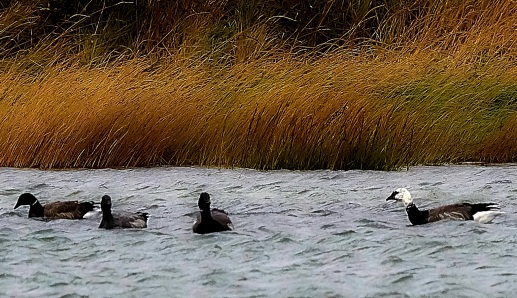
Peter
Milinets-Raby comments that the Goose is a Brent
Goose. Note size in relation to other Brent in photo.
Also it has Brent Goose flank markings and even has a
Brent Goose bill. He thinks it is a Brent Goose with
partial albinism. Interesting individual. It is not
clear from the photos but not a cross with something
else.
Ivy was a mass of
flowers (and insects) and one teasel was also in
flower. Others were green alkanet, scarlet pimpernel,
creeping cinquefoil and common mallow.
At Cobnor Point we had to take shelter behind the
hedge for our coffee break as the wind had increased
to at least gale force nine. Heather spotted a
(probable) sandwich tern and a turnstone flying but
they were soon gone!
On the return path, stonechats, rock pipits and meadow
pipits were still around, and we added buzzard and
grey heron. A flock of about twenty waders, light
brown and with clear pale under parts, banked and
circled a few times before landing in the field beyond
the road. We scanned through a gap in the hedge,
eventually finding and confirming golden plovers
together with a single lapwing.
Thanks to all for braving the windy conditions and for
the help especially in identifying the wild flowers.
Thanks to Derek for the super photos.
FRIDAY
OCTOBER 25 - 2019
Spotted
Redshank
No it's not
arrived yet, but time is running short. In the
meantime I have just come across an excellent blog
written by Graham Appleton called 'WaderTales' in
celebration of waders and wader research. Many of the
entries in Graham's blog are based on previously
published papers with the aim of making wader science
available to a broader audience. What an good idea.
Personally, I love waders and have spent many hours
over the years watching and counting them. I would
like to share Graham's blog with you.
Here is a link to one of Graham's recent blog entries
in which he describes the occasion in July 1975 when
he was involved in catching and ringing an astonishing
60 Spotted Redshanks at Terrington, on the
Lincolnshire border of Norfolk. In the same entry,
Graham also provides interesting details about the
migration and distribution of this cracking wader.
Go to . . . https://wadertales.wordpress.com/2018/07/26/fewer-spotted-redshanks/
THURSDAY
OCTOBER 24 - 2019
Nore
Barn
I made two
visits to Nore Barn this morning, both times with rain
falling. The first time at 10.30 the tide was too
high, so I went home for a coffee and returned after
an hour at 11.30 when the tide was still fairly well
advanced. As Peter Milinets-Raby commented yesterday,
the tide was so very slow in going out. I had a quick
look at the stream where the regular Greenshank and
Common Redshank were feeding happily together, but
there was no sign of the Spotted Redshank.

WEDNESDAY
OCTOBER 23 - 2019
Mystery
plants solved
Ralph Hollins
responded to my query about the mystery plants with
round fruits up the stem which I found on Hayling
Beachlands yesterday. Ralph thinks they are Dark
Mullein (Verbascum nigrum) and having
consulted my flower guides I am sure he is
right.
Here
are pictures of Dark Mullein with flowers all up the
stem (on the left)
with yesterday's plant (on the right) for comparison.
Ralph points out that
the strangely named 'Cock's Eggs' (Salpichroa
origanifolia) plant also grows near the Duke
of Argyll's Teaplant on Hayling Broadlands. He says it
can be found by following the hedge containing the
Teaplant round the corner and up to the road where a
substantial colony of Cocks Eggs grows out from the
hedge. Ralph says this colony has been established for
at least ten years.
Here
are photos of the Cock's Eggs colony
and a close-up of the flowers that I took on
Beachlands at this site in October 2009
so they should be in flower now!
Emsworth
Harbour
Peter
Milinets-Raby had a wander around Emsworth Harbour
this morning for 90 minutes. His report follows . .
.
The tide was going out ridiculously slowly - I'm sure
for 40 minutes the water never dropped!!!
Started at Nore Barn: The regular colour ringed
Greenshank flew in to join the Redshank already in the
stream with a Little Egret. No Spotted Redshank.
Beacon Square: 4 Turnstone, 1 Greenshank, 6
Black-tailed Godwit, 114 Dunlin, 5 Grey Plover, 39
Brent Geese, 1 Stock Dove over, 1 Jay plus 5+ Skylarks
moving through. Emsworth Harbour: (Mill Pond - 19
Coot): 2 Sandwich Tern, 110 Brent Geese, 14 Grey
Plover, 159 Dunlin, 11 Knot, 26 Turnstone, 3
Bar-tailed Godwits, 1 adult winter Mediterranean Gull
(they soon vanish, yet in the creeks and fields to the
east there are loads!). 1 Lapwing, 3 Little Egrets, 1
Kingfisher dashing around the harbour - it couldn't
decide which boat to land on. In the end it choose
"Avocet". 16 Canada Geese, 1 Shelduck.
Back at Nore Barn (from roughly 10:20am) - nothing in
the stream at all!! The Greenshank probably had flown
around to Pook Lane shore like it did the other day.
16 Black-tailed Godwits including G//R + WR//- see
photo taken on mobile phone. 95 Brent Geese - on the
salt marsh - getting closer! 34 Wigeon, 2 Teal, 1
Shelduck, 1 Grey Plover.

Ailing
Black Poplar?
Sarah Hughes
passed our concerns over the Black Poplar on Brook
Meadow which has shed all its leaves very early to
tree expert Julie Bolton.
Photo
shows our two Black Poplars.
The one on the right is the problem tree.

Julie thought the
problem Poplar looked just like normal autumn
shut-down, though cautioned that there's a degree of
variance in genetics and provenance, so not all
Poplars will respond in exactly the same way.
Julie provided a link to further advice on tree health
at . . . https://www.forestresearch.gov.uk/services/tree-health-diagnostic-and-advisory-service/
Bookends
Calendar
Jo Bray tells
me her Bookends calendar is now on sale in the
Emsworth bookshop featuring the Spotted Redshank in
March! Jo has been telling anyone who looks at the
calendar all about it. There's also a photo of Brook
Meadow in May.

White-tailed
Eagles update
It has been
nearly two months now since the young White-tailed
Eagles were released on the Isle of Wight. Since then
they have been closely monitored by rangers and
volunteers. They have had some marvellous views of the
eagles flying and playing in the air. The birds have
continued to explore and develop their skills, finding
food and new places to perch. Most of them remained on
the Isle of Wight and surrounding Solent coastline
while two have made longer exploratory flights, one as
far as the Essex coast. For more details go to . . .
https://www.forestryengland.uk/white-tailed-eagle-project-october-update

TUESDAY
OCTOBER 22 - 2019
Beachlands
Jean and I had
a pleasant walk on a warm and sunny autumn morning
through the Beachlands on SW Hayling Island. The
habitat is mainly sandy heathland and the dominant
plant is Gorse in flower.

The paths were lined
with the grey remnants of Viper's-bugloss plants,
still very attractive in death!

We discovered an Apple
tree loaded with fruit which Jean sampled - really
sweet!

The first bird we
encountered was this superb male Stonechat
perched high on a bush. We subsequently saw
several other Stonechats, male and female. The autumn
song of Robin was everywhere; here is one in action
that I managed to capture.
The Ivy flowers were
attracting myriads of bees along with this Red Admiral
that was totally preoccupied in its nectar feast.

We came across several
mystery plants, tall and stiff stems with round green
fruits. Help appreciated in the identification of this
plant.

Duke of Argyll's
Teaplant
At the far eastern end of Beachlands in hedges
outside gardens, we several plants of found a
scrambling shrub called Duke of Argyll's Teaplant
(Lycium barbarum) which Ralph Hollins
introduced me to many years ago. The photo shows the
site of the plants.

Here are some of the
egg-shaped berries against the sleeve of Jean's
coat.
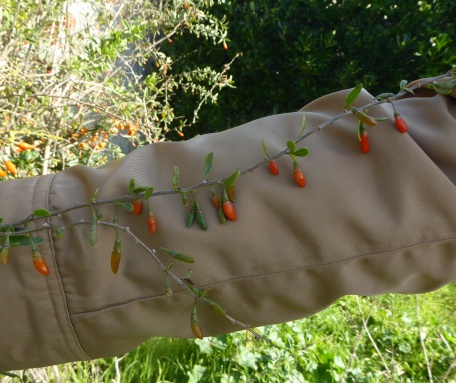
The plant is named
after the Duke of Argyll who introduced it from China
into this country in the 1730s. Apparently, it is now
a widely naturalised plant in hedges over most of the
UK and its berries have been promoted under the name
of goji berries as a health food based on their high
concentration of caratenoids. It is grown commercially
in China from where our supermarket supplies are
imported.
Nore
Barn
I popped along
to Nore Barn at 15.30 this afternoon. No change in the
stream where the regular Greenshank (G+GL) and a
Common Redshank were feeding together, but no sign of
our Spotted Redshank.
MONDAY
OCTOBER 21 - 2019
Nore
Barn
I went to Nore
Barn today at 1.45 for about half an hour on a rising
tide. The weather was calm and cloudy - perfect
conditions for birdwatching. In the stream were the
regular Greenshank (G+GL) and Common Redshank feeding
in close proximity. Peter Milinets-Raby saw this
Greenshank on the Warblington shore earlier at 10.25
this morning, so that is where it gets to. There was
no sign of the Spotted Redshank even though the
conditions were ideal. I am getting slightly anxious,
though there's still time as my first sighting last
year was not until Oct 29.
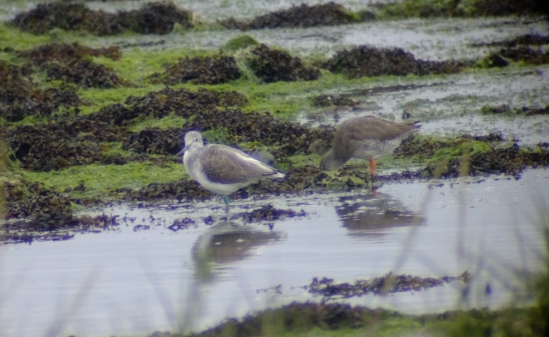
55 Black-tailed
Godwits assembled near the saltmarshes among which I
was able to pick out the following colour-ringed
birds: W+WN, R+LG, B+LG, all of which I have already
recorded at Nore Barn this season.
Here is
Black-tailed Godwit R+LG that I got today

I am grateful to Pete
Potts for sending me the complete history of Godwit
B+LG. It was ringed on 15-Oct-13 at Farlington
Marshes by Pete Potts and his team. There have been 44
subsequent sightings including a few on its breeding
territory in Iceland. My sighting on 19-Oct-2019 was
the first in Emsworth Harbour. Previously this year it
was seen on 02-Jul-19 at Rutland Water by warden Tim
Appleton.
Here is
Black-tailed Godwit B+LG that I got last week on
19-Oct-19

Warblington
shore
Peter
Milinets-Raby visited the Warblington shore this
morning for two hours from 9:10am. His report follows
. . .
The tide was out and
it felt like the start of winter. Waders arrived today
in a trickle indicating that the autumn movement was
over and what was happening from now on is the start
of winter. The details of the morning were as
follows:
Ibis Field: 4+ Blackbirds feeding on berries at the
rear of the field along with 2 Song Thrush, a single
Jay, a single Chiffchaff and a single Redwing.
Overhead were 2 Skylarks, a Grey Wagtail and a
Buzzard.
In the big stubble field to the east by the hay dump
were 21 Stock Dove, 6 Skylark, just one Meadow Pipit,
15+ Linnets and a Kestrel.
On the shore at Conigar Point were 6 Shelduck, 12
Wigeon, 2 Teal, 6 Grey Plover (substantial increase
along the whole shoreline ), 10 Brent Geese (with 76
in the distance in Emsworth Harbour ), 32 Lapwing and
2 Sandwich Terns flying around. In the Tamarisk hedge
were 2 Chiffchaff.
In the SSSI Field were 8 Meadow Pipit, 2 Song Thrush
and 2 male and one female Stonechat.
On the shore off Pook Lane were 3 Knot (the first for
a couple of weeks), 53 Dunlin, 2 Turnstone, 9 Grey
Plover, 4 Greenshank (G//R + LG//- at 10:25am - the
Nore Barn bird), 21 Shelduck, 22 Black tailed Godwit,
4 Bar-tailed Godwits, 7 resting Sandwich Terns, 5
Brent Geese, a single Great Crested Grebe, 2 female
Red breasted Mergansers and on the main hedge was
another female Stonechat. Flying over were 5+ Meadow
Pipit, 5+ Skylark, a Great Spotted Woodpecker and a
noisy flock of 12 Fieldfare that were heading north,
but suddenly dropped out of the sky to land on the
huge hedge in the SSSI Field.
And to finish everything off there 9 cows in the field
south of the cemetery with 2 handsome male Pheasant
and 3 Cattle Egrets. Two were adults with beautifully
clean yellow/orange bills with a wash of orange on the
forehead and crown and the other bird looked like a
first winter/juvenile with greenish yellow/orange bill
and totally white plumage.
SUNDAY
OCTOBER 20 - 2019
Nore
Barn
I got to Nore
Barn at 1.15 with the tide rising to high water in
about 3 hours. The weather was fine and lots of
walkers were out enjoying the autumn sunshine. In
sharp contrast, it was very quiet on the bird front,
so not much to report.
With the winds turning northerly this should favour
the flight of the Spotted Redshank if it was on its
way. However, the only birds in the stream were
Greenshank (G+GL), Common Redshank, 2 Black-tailed
Godwits and unusually 2 Little Egrets (we
usually only have one). Still no sign of the Spotted
Redshank, but keep looking!

I counted 50 Wigeon on
the edge of the main channel along with 64 Redshank
and 3 Dunlin. Looking east towards the main harbour, I
could see a good flock of 50+ Brent Geese, but there
were none in the Nore Barn area. Anyway, it is good to
see they have turned up at last in Emsworth Harbour. A
flock of 33 Black-tailed Godwits flew onto the
edge of the saltmarshes in but I could not check legs
as most were in water up to their bellies. Here are a
few of the Godwits . . .

SATURDAY
OCTOBER 19 - 2019
Nore
Barn
I popped over
to Nore Barn at 12.30pm to do my daily check for the
Spotted Redshank. In stark comparison with previous
days, the conditions were actually quite nice, no
rain, sun shining and just a light wind. The only
birds in the stream were the regulars, Greenshank
(G+GL), Common Redshank and Little Egret along with a
few Mute Swans and Black-headed Gulls. No Spotted
Redshank!
Photo
shows Common Redshank, Greenshank and Little Egret in
the stream

Further out I could
see 40+ Wigeon along with 30+ Redshank just 2 Brent
Geese.
Best of the morning
was a fine flock of 74 Black-tailed Godwits
which gathered near to the shore as the tide came in.
I went through them looking for colour-ringed birds. I
found G+WR and R+LG - both already recorded in
Emsworth this season.
Here
is R+LG

Also present were two
newcomers in Emsworth for this season: W+WN and
B+LG.
W+WN - is an
old friend which (like G+WR) has been regularly
visiting us here in Emsworth over the past 9 years. It
was originally ringed by Pete Potts and his team on
05-Sep-2010 on Farlington Marshes. Our first sighting
in Emsworth was soon after that on 18-Oct-2010 and
since then has been seen 71 times in the harbour.
B+LG - this was
my first ever record of this bird in Emsworth Harbour,
though it has been recorded a few times over the past
2 years by Peter Milinets-Raby at Warblington. I guess
it must have been ringed fairly recently.
Great
White Egrets
Christopher
Evans had the pleasure of seeing and photographing
this Great White Egret this morning at the western end
of the Great Deep on Thorney.

This was probably one
of the two Great White Egrets reported by Barry
Collins on the east side of Thorney Deeps on 8th
October (on the SOS Sightings page). Barry also saw 6
Cattle Egrets feeding in amongst the cattle in one of
the fields nearby (probably from the Langstone Mill
Pond colony.
FRIDAY
OCTOBER 18 - 2019
Warblington
shore
This morning Peter
Milinets-Raby had a wander around Warblington for a
couple of hours - tide out. His report follows . .
.
Cemetery: 3 Goldcrest, 1 Coal Tit, 1 male Pheasant and
a Great Spotted Woodpecker
Ibis Field: 2 Song Thrush and a male Blackcap, 3
Skylark over with a Meadow Pipit.
Big field to the west (new rotting hay mound); 80+
Linnets, 11 Skylark, 9+ Meadow Pipits
Conigar Point: 47 Brent Geese (contained 3 juveniles),
12 Shelduck, 6 Teal, 11 Wigeon, 3 Grey Plover.
SSSI Field: female Stonechat, 1 Kestrel, 1 Meadow
Pipit.
Pook Lane: 6 Grey Plover, 2 Greenshank, 27 Dunlin, 3
Great Crested Grebes, 15 Brent Geese, 4 Shelduck, 3
Stock Doves, 1 Roe Deer (see photo), 1 Skylark over, 5
female Red Breasted Mergansers, 2 Little Egrets in the
fields.

Langstone Mill Pond:
Mute Swan family busy preening, 1 Kingfisher, 8 Teal,
2 Grey Heron and 7 Little Egrets roosting.

Flooded paddock; 43
Teal.
Off shore by the pub: 17 Sandwich Terns - best count
so far this autumn. 4 Common Gulls
Nore
Barn
I went over to
Nore Barn this morning, a couple of hours before high
water, but conditions were pretty awful with gale
force winds into my face and squally showers. I had a
quick look at the stream which held the usual
suspects, Greenshank, Common Redshank and a few
Black-tailed Godwits, but no Spotted Redshank. Did not
stay.
THURSDAY
OCTOBER 16 - 2019
Brook
Meadow workday
The rain was
falling steadily when I got to Brook Meadow where I
found a small group of 8 volunteers huddled together
in the HQ sheltering.

The rain relented
slightly, so Colin Brotherston who was leading decided
to make a start. The main job allocated was to clear
brambles and other undergrowth from the Gwynne Johnson
Rowan plantation on the east side of the north meadow.
This was not easy work in steady rain and occasional
heavy downpours, but the volunteers stuck to their
task until the rain forced them to shelter under
trees.

Video clip of the work
. . . https://youtu.be/aeyGL16BMZs
While this was going
on Dan and Terry had donned their waders and were busy
reinforcing the crumbling river bank north of the
north bridge with Hessian bags of gravel. Sarah Hughes
thinks this should benefit Water Vole habitat. Here is
Dan with a bag.

Meanwhile, Lesley went
off to clean the signcases and hunt for litter with
her trolley. Here she is enjoying the rain among the
Rowans.

I left before coffee
break as the rain got heavier. Dan presented me with a
small jar of apple jelly that he had made from fruit
of the trees on the Seagull Lane patch. How nice of
him.
For the full report
and more photos go to . . . https://www.brookmeadow.org.uk/conservation-news/
Nore
Barn
I had a very
quick visit to Nore Barn at about 12 noon on a rising
tide to check birds in the stream. I hardly got out of
the car when the heavens opened. I managed to see the
regular Greenshank and Common Redshank in the stream,
but there was no Spotted Redshank. But there's still
time.
Garden
birds: to feed or not to feed?
Report from
British Trust for Ornithology: Almost half of the
households in the UK feed their garden birds,
potentially providing enough supplementary food to
support 196 million individual birds! Multiple
independent studies indicate that the genuine pleasure
we gain from feeding birds is what motivates us to
keep doing it. And, irrespective of the joy feeding
might bring us, the practice is built upon a basic
desire to help birds, especially during hard times. On
the other hand, people are often concerned that birds
will become dependent on this additional food and
there is evidence that feeding stations can contribute
to the spread of disease.
Having weighed up all
the evidence, find out if our Garden Research
Ecologist, Kate Plummer, feeds the birds in her
garden. https://bto-enews.org/IG4-6J7AM-3RN36S-3SIKYR-0/c.aspx
One issue Kate raises is . . . are we interfering with
the natural rates of survival of our garden birds by
effectively interfering in natural selection and
artificially inflating the populations of the most
common garden visitors? Helping weaker birds to
survive? Interesting.
Havant
Thicket reservoir
Portsmouth
Water reveals plans for their long awaited reservoir
at Havant Thicket.
To
progress our plans, we'll be carrying out
investigations on the soil and groundwater levels on
the proposed site from late October/early November to
December. This will help us design the reservoir for
the planning application, which we plan to submit to
Havant Borough Council later next year for
consideration. The investigations will use small,
towable drilling rigs and JCB-type excavators to
create boreholes and shallow excavations so we can
take soil samples and put in equipment to monitor
water levels.
The footpaths and public bridleway on the site will
remain open and working hours will be restricted to
between 8am to 6pm, Monday to Friday, and 8am to 1pm
on Saturdays.
We'll be avoiding key areas of sensitive habitats
during the work and it won't affect any of the wooded
areas. When it's finished, we'll restore the
grassland. Weather depending, the final steps of the
restoration may need to be done in the spring.
We appreciate the activities may be seen and heard by
local residents and while we don't expect the work to
cause any disruption, we'll be doing all we can to
minimise any impact.
We'll be working hard to raise awareness of what we're
doing and why - including sending letters to nearly
27,000 homes and businesses in the area over the next
few weeks. We're planning small exhibitions in Leigh
Park and Rowlands Castle in mid November and will post
website and social media updates, email local
representatives and groups and put up posters and site
signs.
We'd appreciate your help to share this information -
whether that's putting up a poster, posting
information on a website or social media channel or
sharing it in an email or newsletter. Please get in
touch and we'll provide any words or material you
need.
More information is
available online at . . . http://www.portsmouthwater.co.uk/havant-thicket-reservoir
TUESDAY
OCTOBER 15 - 2019
Nore
Barn
The weather
turned out very pleasant for this morning's visit to
Nore Barn at about 10.15am with no wind and a warm sun
just starting to break through thin clouds. My visit
was made more pleasurable by meeting Peter
Milinets-Raby who was just completing a morning bird
walk from Emsworth Harbour to Nore Barn - see his very
detailed report below.
Peter and I correspond a lot, but we rarely meet, so
this was a nice surprise. Here is a shot of Peter
surveying the mudflats.

Peter and I stayed
together for about 30 mins as the tide slowly pushed
in filling the stream which contained only its regular
occupants, namely, colour-ringed Greenshank (G+GL),
Common Redshank and Little Egret along with a few Mute
Swans. There was no sign of Spotted Redshank, though
Peter thought it might arrive Thursday or Friday as
the winds are turning northerly to favour its
flight.
We went along the path to the south of the woods from
where we had a fine view of a small flock of 28
Black-tailed Godwits feeding busily (with lots of
'spurting') close to the shore. We spotted the
colour-ringed Godwit R+GL which Peter had seen earlier
in the main eastern harbour. Godwits always move from
the main harbour to Nore Barn as the tide rises. R+GL
can be seen on the far right of this small group in
this photo.

We stood for a while
just watching the Godwits feeding in front of us.
Surely there are few sights as relaxing in
birdwatching than Black-tailed Godwits feeding
together. This short video clip gives a taste of the
experience . . . https://youtu.be/BAerBJBN1bA
Peter also pointed out
my first Grey Plover of the year plus a few Turnstone
in the main channel, doing what they are told! Best of
all was my first small skein of Brent Geese which flew
over from the main harbour to come down on the far
saltmarshes. It should not be long before they come
close in shore, maybe including families.
Brook
Meadow
As the weather
was so fine, on the way home from Nore Barn I had
short walk through Brook Meadow. I had no special
observations, apart from seeing a large number of
Nursery-web spiders (Pisaura
mirabilis) basking on the nettle leaves along
the main river path, some in classic pose with their
two front legs stretched out , while others were in
various degrees of having their legs screwed up.
Emsworth
Harbour . . . Peter
Milinets-Raby's report . . .
Beacon Square: from 9am - tide slowly coming in
(Misty/foggy start, sun pushing out)
7 Swallows. 1 House Martin - possibly one of my latest
sightings. 3 Meadow Pipits over, 2 Grey Plover.
Emsworth Harbour: 17 Black-tailed Godwit (R//R +
LG///-). Most of them moved off west and some ended up
at Nore Barn as proved by the coloured ringed bird
being present. 47 Brent Geese, 34 Turnstone, 4 Dunlin,
1 Grey Plover, 4 Little Egrets, 3+ Skylark heard
passing over with 3+ Meadow Pipits.
Mill Pond: 18 Coot and a Great Black-backed Gull.
Nore Barn: From 10am for an hour. 2 Greenshank (G//R +
GL//- colour ringed bird in the stream with one heard
calling elsewhere on the marsh). 32 Wigeon (about four
males in full winter plumage, the rest still in
eclipse), 28 Black-tailed Godwit (the earlier Emsworth
Harbour bird R//R + LG//- now present). 7 Mute Swan, 1
Grey Plover, 4 Turnstone, 1 Teal.
Birds passing over: 4+ Meadow Pipits, 12+ Skylarks,
Siskin heard.
MONDAY
OCTOBER 14 - 2019
Nore
Barn
I got to Nore
Barn at 10am for my regular birds check - tide rising
to high water in about 2 hours. With little wind and
rain holding off the conditions were quite good,
though the light was poor for photography. I had a
chat with Roy Ewing who was off to do some serious
work with a slasher in his hand.
View
of the stream at Nore Barn with tide
rising

I stayed for over 30
mins as the tide came in and gradually filled the
stream. There was no Spotted Redshank, but its three
regular feeding companions were all present and
waiting - Greenshank (G+GL), Redshank and Little
Egret.

A second Little Egret
was quickly chased off from this prized feeding area
by the 'resident' Egret.
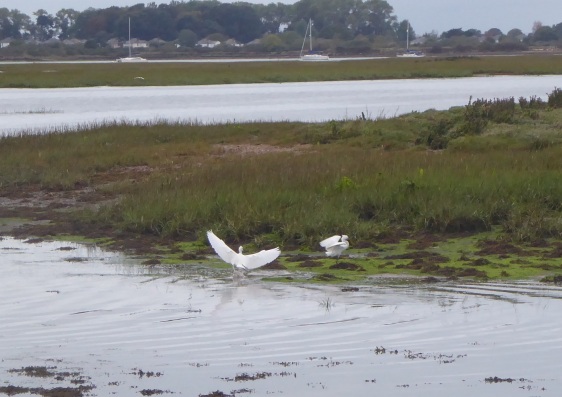
A flock of 50
Black-tailed Godwits was pushed into the creek
south of the woods as the tide came in. I checked them
for colour-rings and was very pleased to discover an
old friend with the colour combination G//R+WR (Left
leg green over red: right leg white over red).

This bird has been
recorded in Emsworth every winter for the past 11
years with a total of 127 sightings! It was first
recorded in Emsworth on 19-Nov-08. Black-tailed Godwit
G+WR was originally ringed at Farlington Marshes by
Pete Potts and his team on 10-Sept-08 as an adult male
which must make it at least 12 years old. This is a
good age for a Black-tailed Godwit, though not a
record as I think they live up to 20 years.
I could see Redshank
and Wigeon further out in the harbour, but no sign of
any Brent Geese as yet.
Langstone
Mill Pond
Peter
Milinets-Raby luckily managed to find a dryish hour
down Langstone Mill Pond this morning from 9am - low
tide, but pushing in.
On the muddy foreshore were 11 resting Sandwich Terns,
along with 1 summer plumaged Grey Plover and 24
Black-tailed Godwit with 2 Great Crested Grebes in the
channel.
On the pond was a very active Kingfisher dashing
around the pond fairly frequently, along with 18 Teal,
one Chiffchaff and one juv Tufted Duck (see photo -
complete with muddy-yellow eye). Overhead were Meadow
Pipit calling along with Skylark. At least 37+
Swallows moved through.

In the flooded paddock
were 29 Teal (all still in eclipse), 1 Green
Woodpecker rummaging for ants, one Pheasant and a
Water Rail heard squealing from the hedgerow.
Off shore in the distance off Conigar Point were a
flock of 26 Brent Geese.
SUNDAY
OCTOBER 13 - 2019
Nore
Barn
I arrived at
Nore Barn at 10am with a fierce SW wind blowing in my
face. The tide was rising to high water in about 2
hours. The stream had three of its regular occupants,
colour-ringed Greenshank (G+GL), Common Redshank and
Little Egret feeding in close proximity, but there is
still no sign of the Spotted Redshank. Here are the
Greenshank and Redshank.

The first sighting
date of the Spotted Redshank has got increasingly
later over the past three years, 11-Oct (2016), 22-Oct
(2017) and 29-Oct (2018), so I am not unduly concerned
as yet, but one year it will not arrive.
For all previous
arrival dates go to . . . Spotted
Redshanks at Nore Barn
SATURDAY
OCTOBER 12
Havant
Thicket
Heather Mills
reports on this morning's walk by the Friends of
Wildlife group
On a somewhat soggy morning 4 attended Havant Thicket
to see what fungi we could find as well as a few
welcome birds. From the car park there were a few Coal
Tits with Great and Blue and Long-tailed foraging high
in the Silver Birches. Occasional Jays passed
overhead. Although we missed most of the rain, the
terrain was very wet and the fungi species attacked by
slugs as one of Derek's picture shows. I have tried to
identify a few but not with certainty. The most
prolific were Fly Agaric and Pestle as well common
Puffballs. It was good to find a trail of Helvella in
a few spots along the tracks.
Fly Algaric . . .
Common Puffballs . . . Helvella . . . Parasol
Sulphur Tufts
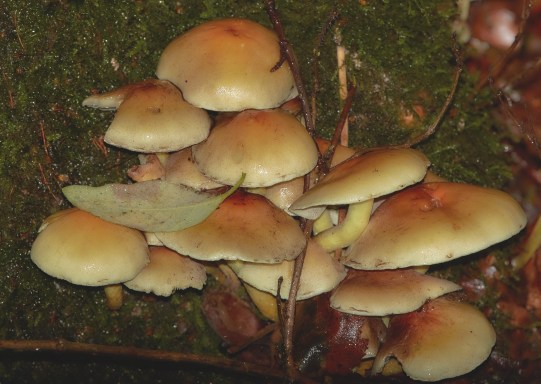
THURSDAY
OCTOBER 10 - 2019
Nore
Barn
I popped over
to Nore Barn at 2pm on a falling tide. It was very
windy! The stream was already quite low; there was no
sign of Spotted Redshank as yet, or Greenshank if it
comes to that, though the regular Common Redshank was
present.
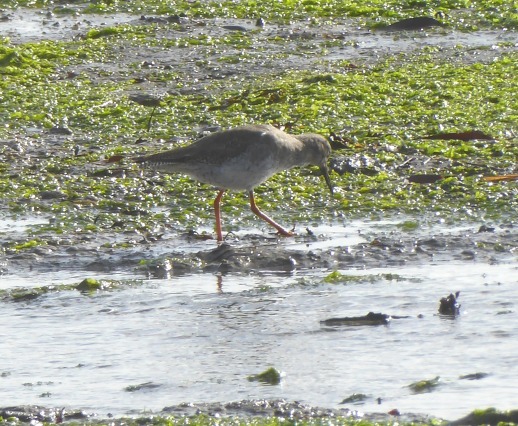
I counted 35
Black-tailed Godwits variously feeding and snoozing on
the edge of the stream and on nearby mudflats, they
included just one colour-ringed bird with the
combination R+LG - also seen by Peter Milinets-Raby
yesterday. Also in the stream area were 30+ Wigeon
plus a few Redshank and an odd Curlew or two. There
were more Redshank further out that I did not
count.
I was pleased to meet Jo Bray and her friend near the
stream. Jo runs the bookshop in Emsworth and is
planning a calendar for 2020 which will include a
rather nice photo of our own Spotted Redshank taken by
Jo. I also met Peter from Penny Lane who was keeping
an eye out for the Spotted Redshank.
Bird
Aware Solent
Peter Milinets-Raby met Emily from Bird Aware Solent
at Nore Barn yesterday and thinks she's doing a
sterling job!

Bird Aware Solent is
an initiative to raise awareness of the birds that
spend the winter on the Solent, so that people can
enjoy the coast and its wildlife without disturbing
the birds. Every year up to 125,000 waders and
wildfowl fly here from as far as the Arctic. This
makes the Solent coast of worldwide importance for
wildlife. These birds need to feed and rest
undisturbed so that they can survive the winter and
build up enough energy to fly back to their summer
habitats. Their survival relies on everyone helping to
prevent bird disturbance. Their rangers engage with
visitors and communities along the coast to help
people learn about the different species of bird and
understand the impact of bird disturbance.
See their web site for more details . . .
https://www.birdaware.org/
Oysterbeds
Tern Rafts - Urgent request
From Wez Smith
(RSPB Warden)
I'm
in need of around 8 (or more) volunteers to help me
lift the nesting rafts at the West Hayling Oysterbeds
this weekend. The recent spring tides and high winds
have been straining them and the smaller of the rafts
has now beached itself in the corner of the lagoon
(the wrong place sadly). With the weather forecast to
get worse but a period of calm on Saturday and Sunday,
I need to take the opportunity if possible and get
them ashore. I'm after a group of people to simply
help me lift them up onto the nearest bund (the other
side of the tidal weir) where they'll be staked down
for the winter above the storm surge lines.
I'm hoping this can be done on Saturday or Sunday but
timing will depend on peoples availability. If you
could pass this request on to your contacts I would
greatly appreciate it.
Anyone who is free to help, please email me on this
address wez.smith@rspb.org.uk
or give me a call on 02392 474440 (leave a message if
I'm out).
The nesting rafts helped fledge 75 common tern chicks
this year, a great result. Everything is secured at
the moment but with the tides now growing again, I'd
to get them in a better position as soon as
possible.
The two rafts in
May this year

WEDNESDAY
OCTOBER 9 - 2019
Mystery
bug solved
I asked our
friendly entomologist Bryan Pinchen about the mystery
bug photo from Chris Oakley yesterday.

Bryan replied to say .
. . "It's
a close relative (of Shield Bugs), called the Western
Conifer Seedbug (Leptoglossus occidentalis). They
first started turning up in southern Britain about 10
years or so ago, usually at this time of year and
often at illuminated windows or moth lights. It is
native to North America, but seems to be colonising
Britain from southern European (introduced)
populations. Not sure if it's yet established as a
breeding species here. Always impressive to see and a
great find. It's been a few years since I last came
across one".
PS Chris subsequently
did manage to track it down to the Western Conifer
Seedbug. Well done, Chris. Has anyone else seen one
locally?
Malcolm
Phillips is back
Malcolm
Phillips, who now lives in Cuba, is back in Emsworth
for 2 or 3 weeks. He managed to get back to UK after
the Thomas Cook collapse so will be here until he can
find a way of getting back to Cuba. The main problem
is that TC was the only company to fly to his end of
Cuba (the far east) so now it is difficult to find a
way back.
Malcolm wasted no time in getting onto Brook Meadow
where he has lost none of his knack for geting nice
wildlife photos. Today despite the bad weather he
managed to get several butterflies and insects. We
look forward to more from Malcolm.
PS Malcolm apologises
for the quality of some of his images which had to be
taken with his phone.
Peacock
. . . Red Admiral . . . Small Copper . . . Speckled
Wood
Hornet
. . . Common Darter
Emsworth
Harbour
Peter
Milinets-Raby had a 90 minute wander around Emsworth
Harbour this lunchtime on a falling tide starting at
12:28pm. The tide seemed to take ages to drop and the
waders took an age to fly in.
Emsworth Harbour: 2 Turnstone. 1 Little Egret. 1
Black-tailed Godwit, 1 Greenshank,
Beacon Square: 1 Greenshank, 1 Dunlin.
Nore Barn: 31 Wigeon eventually flew in. They are
strange things to look at when they are still in
eclipse plumage, the males (except one) had very dark
ginger brown heads with extreme patterning on the
mantle, whilst the females (not many observed) were
paler headed. It was great to hear their calls again
echoing across the harbour. It will be the geese
next!

36 Black-tailed Godwit
(one with colour rings R//R + LG//-). 2 Greenshank
(one with colour rings YO//- + YY//-

1 Turnstone. 110+
Redshank (two with colour rings -//G + G//YG &
-//B + B//NO). 3 Little Egrets.
Emily from Bird Aware Solent was on site and passing
on her message to many passer-by's. Doing a sterling
job (I promised her a Website link ??? - Many thanks
Brian)
Plus I had a brief visit to my Havant garden fence of
a juvenile/female Sparrowhawk (See photo - can see the
pale edging to the shoulder feathers suggesting
juvenile plumage)

Brian's
notes:
Black-tailed Godwit R+LG has been a fairly regular
visitor to Emsworth Harbour since 2013. Also, seen at
Langstone and Warblington.
Greenshank YO+YY - Ringed 8 Sep 2013. Seen only
occasionally in Emsworth Harbour.
TUESDAY
OCTOBER 8 - 2019
Nore
Barn
The tide was
still fairly high by the time I got to Nore Barn at
about 10.30am. I stayed for about an hour as the
stream slowly emptied. There was little of interest on
the bird front, just a lingering Mute Swan cygnet and
a snoozing Black-tailed Godwit. No sign of Spotted
Redshank or Greenshank.
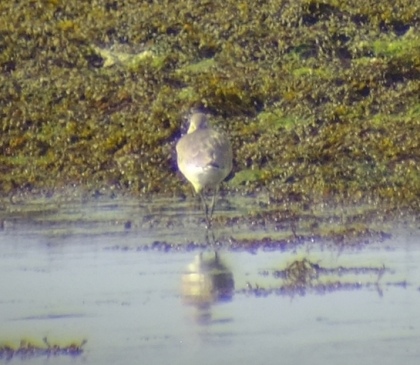
Further out in the
main channel I could just make out a group of three
Wigeon - my first of the new season. As I was watching
them a flock of Redshank flew in and settled on the
edge of the saltmarshes close to the Wigeon. I counted
53 Redshank, though there could have been more. Here's
a digiscoped photo of the Wigeon and a few
Redshank.

Langstone
Mill Pond
Peter
Milinets-Raby had a high tide visit to Langstone Mill
Pond this morning from 9am to 10:11am. His report
follows . . .
I had my first returning Brent Geese, with 15 of them
out in the channel, plus my first wintering Water Rail
on the island on the pond.
Other species of note were: A 60+ flock of Redshank
were milling about trying to decide where to roost,
with them were 7 Dunlin and 6 Greenshank. In the end
they opted for the island in the middle of the channel
that also played host to 7 Lapwing. Also perched on
the buoys were 2 Sandwich Terns.
Off Conigar Point were 3 Great Crested Grebes and 8
Shelduck.
On the pond were 3 juvenile Tufted Duck, the family
group of Mute Swans with one cygnet demonstrating its
flexibility.

1 Kingfisher darted
across the pond, a tit flock of 8+ Long-tailed Tits,
5+ Blue Tits and 5 + Great Tits held 3 Chiffchaff.
Also 31 Teal, 1 Sparrowhawk and a little bit of
movement with 3 Skylarks over south.
Mystery
Shield bug
Chris Oakley
found this rather dramatic insect in the garden this
afternoon. It looks like a Shield bug, but certainly
not one I am familiar with. Nor can I find it in any
of my insect guides or on the internet. Does anyone
know what it is? I will consult our 'resident
entomologist' Bryan Pinchen.
Great
White Egrets on the move
Since the
early 2000s, numbers of Great White Egrets have
increased considerably in Britain, with breeding first
recorded in the Somerset Levels in 2012. Breeding has
continued in Somerset, and in 2017, Great White Egret
also bred for the first time in Norfolk. While still
scarce in Ireland, numbers are similarly increasing
and is now regularly recorded at larger wetland
sites.
Great White Egret sightings peaks in late summer and
early autumn. The highest counts logged in BirdTrack
came from Somerset, with 10 logged at Chew Valley Lake
in mid September, while a flock of 11 were seen flying
offshore past Sheringham, Norfolk.
Locally, Great White Egrets are regularly recorded at
Blashford Lakes and occasionally on Thorney Deeps
where Richard Somerscocks got this image of a Great
White Egret and a Little Egret in 2012. A nice
comparison of their respective sizes.

MONDAY
OCTOBER 7 - 2019
Water
Vole survey
I met up with
Dan Mortimer, Terry Lay and Sarah Hughes at the tool
store on the Seagull Lane patch at 9am as previously
arranged for the Water Vole survey. David Minns was
also present. I took a group photo.

Sarah decided to
survey the north river from the north bridge to the
railway tunnel. Dan and Terry joined her in the river.

Meanwhile David and I
followed on the river path. It was really interesting
to see Sarah working methodically, probing and
smelling. She found several burrows, foot prints and a
bit of poo.

Sarah thought the area
on the bend was a beautiful area for voles with
copious vegetation and good banks. Dan and Terry
picked up litter as they went.

Her colleague Alison
joined us later, she's an entomologist who I met on
the Brook Meadow walk.

All four of them
ventured into the tunnel under the railway where Sarah
and Alison checked out spiders.

Finally, I led Sarah
over to the Lumley Stream which she was most excited
about, the banks being soft and ideal for Water Voles,
but really needs more vegetation. Dan will try some
Common Reed planting.

Sarah detected one
burrow with recent markings by a reed clump which I
shall need to keep an eye on.

Other
observations
While on the
north path I spotted a small flowering plant which
looked like Cow Parsley, but its stiff and rough stems
indicated Rough Chervil. Fresh leaves of Cow Parsley
were growing nearby allowing for ready comparison.
This late flowering umbellifer is a rare plant on the
Brook Meadow site; the only other location for it
being on the edge of Lumley Road.

On the way to the
Lumley Stream I asked Sarah and Alison to have a look
at the ailing Black Poplar tree. They confirmed the
leaves had suffered a blight and there was not much
that could be done. We just have to wait until next
year. We delighted in a fresh Red Admiral which
settled on the trunk of the tree in the warm autumn
sunshine.

We also spotted a
large dragonfly which conveniently perched for us to
identify it as a male Southern Hawker - fairly common
on the meadow at this time of the year.

Sarah spotted a
possible growth of Japanese Knotweed in the stream
near the bend. I brought a sample home. I am fairly
sure it is not Japanese Knotweed, but I am not sure
what it is.
SUNDAY
OCTOBER 6 - 2019
Brook
Meadow
Workday - It
was a fine and bright morning for this morning's work
session with a good turn out of 10 volunteers led by
Maurice Lillie.

The main tasks were
(a) to continue clearing the tree cuttings from the
north meadow and use them to reinforce the north
path

and (b) to cut and
clear the main orchid area. Nigel had already made a
start by using the power scythe to cut the area.

Video clip of the work
. . . https://youtu.be/4cWvQSgvrRs
Dan and Terry planted
a tray of Pendulous Sedge seedlings on the edge of the
river below the north bridge that Dan had grown from
seeds from plants in Palmer's Road Copse.
Dan announced that Sarah Hughes would be coming
tomorrow at 9am to carry out a second Water Vole
survey on the river.
For a full report on
the work session and more photos please go to . . .
https://www.brookmeadow.org.uk/conservation-news/
Wildlife
I discovered a
small Holm Oak sapling of on the river bank on
the north path that I had not seen before. It was
partly hidden by Brambles, but looked healthy. The
younger leaves of this tree tend to be spiny, green on
top and felted white beneath. I pointed it out to
Maurice and Colin who promised to keep an eye on it.
The only other ones I am aware of on the Brook Meadow
site are just outside the south gate. However, I am
sure there will be others in the two copses.

A Common Toad
was disturbed while volunteers clearing the orchid
area. They managed to avoid damaging the creature and
I got a photo and video as it scrambled into safety of
the remaining undergrowth.

Video clip of the Toad
. . . https://youtu.be/e74EWoDRzzY
It was good to see the
first Michaelmas Daisies opening on the far
side of the Lumley area by the stream. These plants
are always late flowering and provide a useful nectar
source for late flying bees and butterflies.
The only butterfly I managed to capture on camera
today was a Speckled Wood basking in the warm
sunshine.
FRIDAY
OCTOBER 4 - 2019
Brent
Geese
Yes, the
Brents are back! On Wed 2 Oct Barry Collins counted at
least 2100 Dark-bellied Brent Geese resting on the sea
just off Pilsey Sands at the southern end of Thorney
Island. That is excellent news. They should be back in
Emsworth Harbour in the next few weeks and then
throughout the winter.
Here's a small
flock of Brents feeding in Emsworth Harbour that I
took a few years ago

Barry says there was
also a Osprey perched on a wooden stake near South
Stakes Island. Other birds of note included 11
Wheatears on the airfield and 5 Cattle Egrets feeding
in amongst the cattle on the east side of the Great
Deep. (As reported on SOS Sightings).
THURSDAY
OCTOBER 3 - 2019
Nore
Barn
When I arrived
at Nore Barn at 1.30 the tide was rising to high water
in about 2 hours and the stream was filling. There was
no sign of the Spotted Redshank, though three of its
'friends' were present, namely Little Egret,
colour-ringed Greenshank (G+GL) and Common Redshank.
The Common Redshank
can be confused with the Spotted Redshank, but its
plumage is much browner and its bill shorter than that
of the Spotted Redshank. Here is today's Redshank -
waiting for its friend?

I met Peter Bullen
from Penny Lane Southbourne who had also come to look
for the Spotted Redshank. Peter had previously sent me
photos of Swallows perched on wires (July 2).
I spoke to Roy Ewing who told me that English Nature
had published details of the coastal path around
Britain. He thought this would hasten the construction
of the new footpath extension and bridge at Nore Barn.
WEDNESDAY
OCTOBER 2 - 2019
Langstone
Mill Pond
Peter
Milinets-Raby donned his padded coat this morning for
a slightly chilly walk around Langstone Mill Pond from
9am to 10:15am. Bright sunshine. Low tide. His report
follows . . . .
The highlights were a 20 centimetres close up view of
a Kingfisher - albeit it only lasted half a second! I
was partly leaning against the fence at the back of
the Mill, looking out across the pond. When I
registered a whirl of fast flapping wings, then a
Kingfisher zipped by only 10 centimetres over the
fence and barely 20 centimetres passed my right ear.
It then dropped down to skim away across the pond,
only inches from the surface. Stunning views of its
turquoise rump glinting in the sunshine. Wow!!
Also, unusually I had a perched male Sparrowhawk in
the Willows at the rear of the pond. I think it had
just eaten, as it preened for 20+ minutes and
regurgitated a pellet (see photo).

Other birds on the
pond this morning were 2 juvenile Tufted Duck (see
photo), a pair of Gadwall, a female Shoveler, 33 Teal
(mostly asleep - see photo), 1 partial summer plumaged
Little Grebe
Also 2 Chiffchaff, a
male Blackcap and 3 Little Egrets (all juveniles see
photo via phone),

Overhead were 1
Swallow, 1 House Martin, Skylark heard and 12+ Meadow
Pipits.
On the low tide mud were 8 Sandwich Terns and 1 Common
Gull. Seem to be waiting for the winter stuff to
arrive. The migrant waders have passed through and
there is nothing around!!
Dead
Swan
Maggie Gebbett
reports a dead Swan on the shore by the south path
through Nore Barn Woods. She did not see the incident
happen but thinks it is recent. So sad. She hopes it
wasn't a dog off lead. That corpse looks pretty
mangled - work of a Fox?

For
earlier entries go to . . . September
1-30